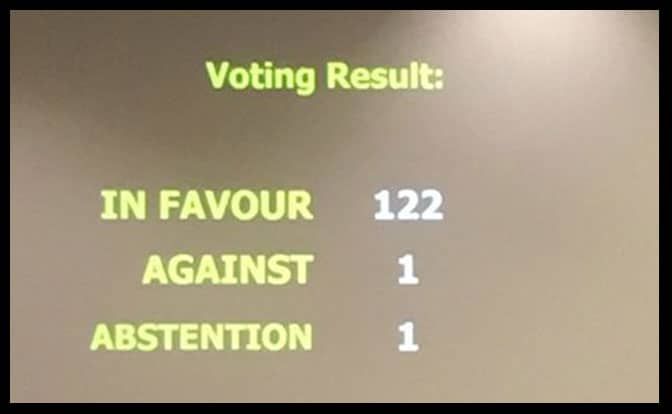A treaty is reached to ban nuclear arms. Now comes the hard part.
By Dan Drollette Jr | July 7, 2017

And so the ban treaty is adopted. This is great news, which we have all been waiting for. All the participants deserve a well-earned moment of celebration; this marks the first time that a global treaty has been negotiated that could lead to the destruction of all nuclear weapons and prohibit their use forever. As we noted in the Bulletin in the latest Ban Brief, this is the successful culmination of the efforts of thousands of ordinary citizens in the streets; millions of people had signed petitions in support of it.
The first news about it came from tweets at the United Nations in New York City; the joy was palpable in lines such as “We have just made history! The #nuclearban treaty is adopted!” Screenshots of the final vote were eagerly shared.
But it is very important to note that adopting the treaty is not the same thing as it being formally signed, which will only begin on September 20. And signing is not the same thing as going into effect—the treaty needs 50 nations to ratify it, and only then will it become binding international law. All of which the New York Times noted in an article aptly titled “A treaty is reached to ban nuclear arms. Now comes the hard part.”
Nevertheless, the treaty to ban nuclear weapons marks a significant step. And the timing could not be more apt, at a moment on the world stage when the opening sentence of an Associated Press article says that “A pre-emptive military strike may be among the “pretty severe things” President Donald Trump says he is considering for North Korea…” even if it then hedges by calling it “as among the unlikeliest options.”
A group of experts—including Georgetown University’s Robert L. Gallucci, former Los Alamos director Siegfried S. Hecker, retired senator Richard G. Lugar, former US Secretary of Defense William J. Perry, Governor Bill Richardson, and former US Secretary of State George P. Shultz—were concerned enough to send an open letter to the White House on June 28 that called for discussion with North Korea in order to avoid nuclear catastrophe. Crucially, it noted that “Talking is not a reward or a concession to Pyongyang and should not be construed as signaling acceptance of a nuclear-armed North Korea… This effort should begin with informal bilateral talks—with no preconditions—to explore options for more formal negotiations.”
And as Perry wrote in a separate statement released on July 7: “Nuclear catastrophe is one of the greatest existential threats facing society today, and we must dream in equal measure in order to imagine a world without these terrible weapons.”
Publication Name: New York Times
To read what we're reading, click here
Together, we make the world safer.
The Bulletin elevates expert voices above the noise. But as an independent nonprofit organization, our operations depend on the support of readers like you. Help us continue to deliver quality journalism that holds leaders accountable. Your support of our work at any level is important. In return, we promise our coverage will be understandable, influential, vigilant, solution-oriented, and fair-minded. Together we can make a difference.
Keywords: TPNW, Treaty on the Prohibition of Nuclear Weapons, nuclear ban treaty
Topics: Nuclear Weapons, What We’re Reading















